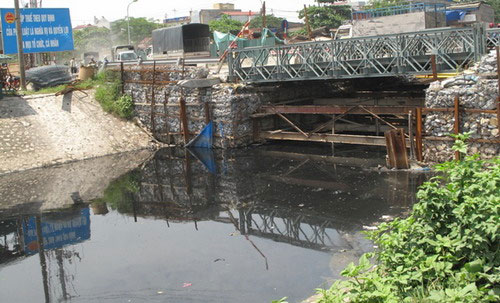Hanoi: VND 1,329 billion for environmental rescue
On the morning of July 15, Hanoi City People's Committee submitted to the City People's Council to consider the Hanoi environmental rescue project from now to 2010. Accordingly, the City will spend 1.329 billion dong from the investment budget for pollution treatment projects. In which, 1,019 billion VND implemented eight pollution treatment projects and 310 billion for district solid waste treatment projects.
Excessive pollution
According to the Vice Chairman of Hanoi People's Committee Vu Hong Khanh, the three most pressing environmental pollution problems in Hanoi today are: surface water pollution, air pollution due to dust, and solid waste pollution. . Monitoring results in the first six months of 2009 showed that at 250 test points, there were 180 points with suspended dust content exceeding the permitted standard (72%). The amount of dust at Nguyen Trai road exceeds 11 times, Nguyen Van Linh road is 10.8 times higher . Air pollution due to traffic emissions is also at an alarming level with 30/34 crossroads with SO2 concentration. NO2, C6H6 exceed the allowed standard.
The People's Committee of Ho Chi Minh City said waste water from industrial facilities is dispersed only 20-30%, only 8/48 hospitals and health centers managed by the city have waste water treatment systems. Even more amazing when the whole city has up to 1,310 villages with 'say no' to wastewater treatment activities. That is not to mention the rivers and lakes are being subjected to death by thousands of cubic meters of wastewater every day untreated, massively discharged to the manhole.

Many of Hanoi's rivers have only one black color due to polluted wastewater discharged throughout the day and night (photo taken at Nhue-HN river) - (Photo: Xuan Long)
Department of Natural Resources - Environment City said among the rivers of Hanoi, To Lich River, Kim Nguu, Ngon River, Lu River . almost only black and became the most polluted rivers. The lakes near residential areas such as Dong Da Lake, Giang Vo, Thanh Cong and Thanh Nhan all have coliform levels exceeding 100-200 times. In the dry season, coliform levels exceed the standard at record levels, more than 700 times the permitted target.
According to incomplete statistics of Hanoi Department of Natural Resources and Environment, the amount of industrial solid waste discharged to Hanoi every day is about 750 tons, 85-90% of this amount is collected but only 60% of collected quantity can be treated. . However, the current landfill sites in the city are also at an alarming level. At the end of 2009, the Xuan Son waste treatment area (Son Tay) has no vacant space and the Nam Son waste treatment complex. also filled in 2011.
Priority for heavily polluted areas
According to the leader of the People's Committee of Ho Chi Minh City, the project on treating environmental pollution by 2010 is one of the urgent solutions because it cannot be polluted further in the city. However, to get the amount of VND 1,329 billion to implement projects, the City needs to be approved by the City People's Council and this is being considered by the People's Council.
According to Vice Chairman Vu Hong Khanh, Ho Chi Minh City People's Committee, when this project is approved, heavily polluted areas will be prioritized to be treated first, at the same time build more solid waste treatment and solid waste management points. Hazard in health and industry and treatment of environmental pollution on river routes.
Khanh said that in the short term, the city will expand solid waste treatment areas such as Nam Son (Soc Son) and Xuan Son (Son Tay), build a number of solid waste treatment plants with advanced technologies. . For To Lich river, a 1km upstream pilot project will be invested with the aim of ensuring the criteria of drainage, environment and landscape. Accordingly, this project will follow the principle of separation and collection of wastewater on both sides of the river, construction of a small-scale treatment station and water after treatment to discharge into the river.
For other polluted river routes, TP affirmed to carry out a series of dredging and treatment projects and pilot construction of a local wastewater treatment plant at the discharge gates. As for the lake system, in 2009, the city will test some solutions to reduce and reduce the pollution of seven lakes and continue to treat pollution in the remaining 26 lakes in 2010. According to the People's Committee In the period 2009-1010, the city will invest in building a wastewater treatment station in 12 hospitals and medical centers.
- Hanoi spent more than 3 billion VND for environmental planning
- Hanoi restricts the use of plastic bags
- Hanoi atmosphere 'dirty first in Asia'
- Warning of Hanoi environment
- 500 billion chartered capital to promote environmental activities
- The most modern museum in Vietnam needs an additional VND 760 billion to complete
- What's more than 60 billion VND in Hanoi Observatory in Hanoi?
- Video: A rare film about Hanoi street 50 years ago
- Meeting to rescue the Hinh river crocodile
- Hanoi: Radon toxic gas?
- Mistakes 'dumbfounded' when using an airplane rescue jacket that few people thought of
- Shoot clouds, prevent rain cost 1 billion USD?
 Is the magnetic North Pole shift dangerous to humanity?
Is the magnetic North Pole shift dangerous to humanity? Washington legalizes the recycling of human bodies into fertilizer
Washington legalizes the recycling of human bodies into fertilizer Lightning stone - the mysterious guest
Lightning stone - the mysterious guest Stunned by the mysterious sunset, strange appearance
Stunned by the mysterious sunset, strange appearance